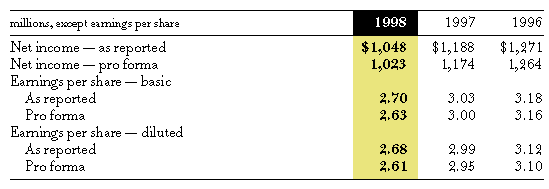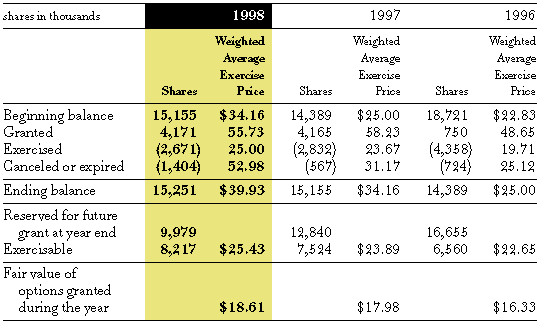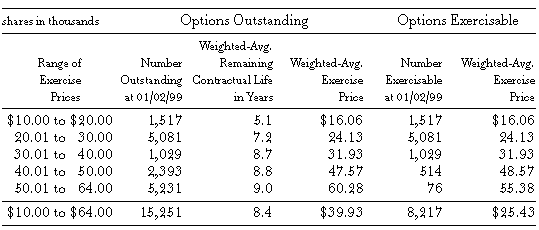 |
| 14. STOCK BASED COMPENSATION
Stock Option Plans Additionally, certain options were granted in 1997 with performance-based features that required the Company's share price to reach specified targets at three- and five-year intervals from the grant date to be earned. In February 1999, the Company extended the period of time allowed to meet the specified targets by one year. The Company had 1.2 million and 1.4 million performance-based options outstanding at the end of 1998 and 1997, respectively. Subject to the satisfaction of the performance-based features, these performance-based options vest 50% in year six, 25% in year seven and 25% in year eight from the time of grant. The Company did not recognize compensation expense in 1998 or 1997 related to these options because the exercise price exceeded the Company share price at both year ends. The Company measures compensation cost under Accounting Principles Board Opinion No. 25, "Accounting for Stock Issued to Employees," and no compensation cost has been recognized for its fixed stock option plans. In accordance with SFAS No. 123, "Accounting for Stock-Based Compensation," the fair value of each option grant is estimated on the date of grant using the Black-Scholes option-pricing model. The following assumptions were used during the respective years to estimate the fair value of options granted:
On May 8, 1997, the shareholders approved the Company's Associate Stock Ownership Plan ("ASOP"). The ASOP allows eligible employees the right to elect to use up to 10% of their eligible compensation to purchase Sears common stock on a quarterly basis at the lower of 85% of the fair market value at the beginning or end of each calendar quarter. The maximum number of shares of Sears common stock available under the ASOP is 10 million. The first purchase period began January 1, 1998, and 0.6 million shares were issued under the ASOP in 1998. 15. SUMMARY OF SEGMENT DATA The Company is a multi-line retailer providing a wide array of merchandise and services, and no single product or service accounted for a significant percentage of the Company's consolidated revenue. The Company has four domestic segments, which include the Company's operations in the United States and Puerto Rico, and one international segment. The domestic segments are Retail, Services, Credit and Corporate. The Retail segment includes the operating results of the Company's Full-line Stores, Home Stores and Auto Stores, and the Services segment includes the operating results of the Company's Home Services and Sears Direct businesses. These businesses have been aggregated into their respective reportable segments based on the management reporting structure and their similar economic characteristics, customers and distribution channels. A general description of the merchandise and services offered in each segment follows: Retail Services Credit Corporate International The segments do not record intersegment revenues and expenses. External revenues and expenses are allocated between the applicable segments. The domestic segments participate in a centralized funding program. Interest expense is allocated to the Credit segment based on its funding requirements assuming a 9-to-1 debt to equity ratio. Funding includes debt reflected on the balance sheet and investor certificates related to credit card receivables sold through securitizations. Services is allocated interest income based on the after-tax cash flow it generates through the sale of service contracts. The remainder of net domestic interest expense is reported in the Retail segment. The Company's segments are evaluated on a pretax basis, and a stand-alone income tax provision is not calculated for the individual segments. The Company includes its deferred income taxes within the Corporate segment. The other accounting policies of the segments are substantially the same as those described in the Company's summary of significant accounting policies footnote. |
Annual Report Contents | Previous | Next | |



